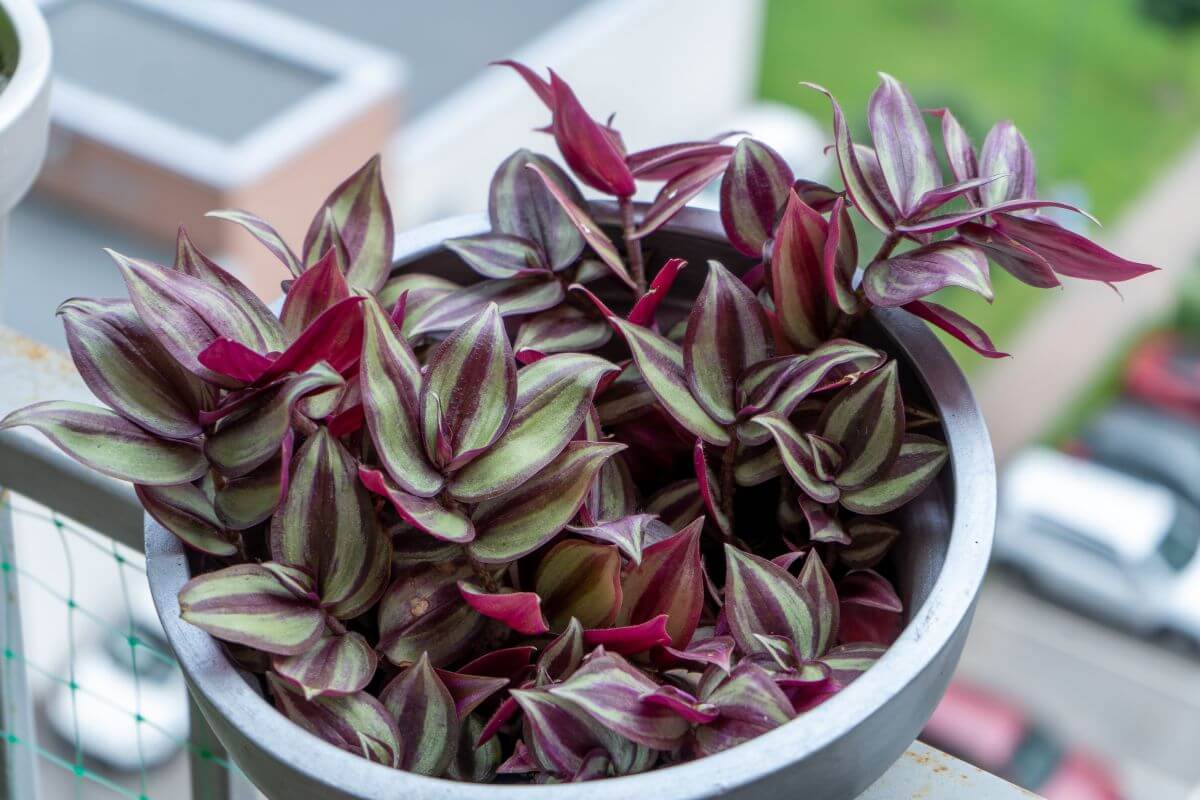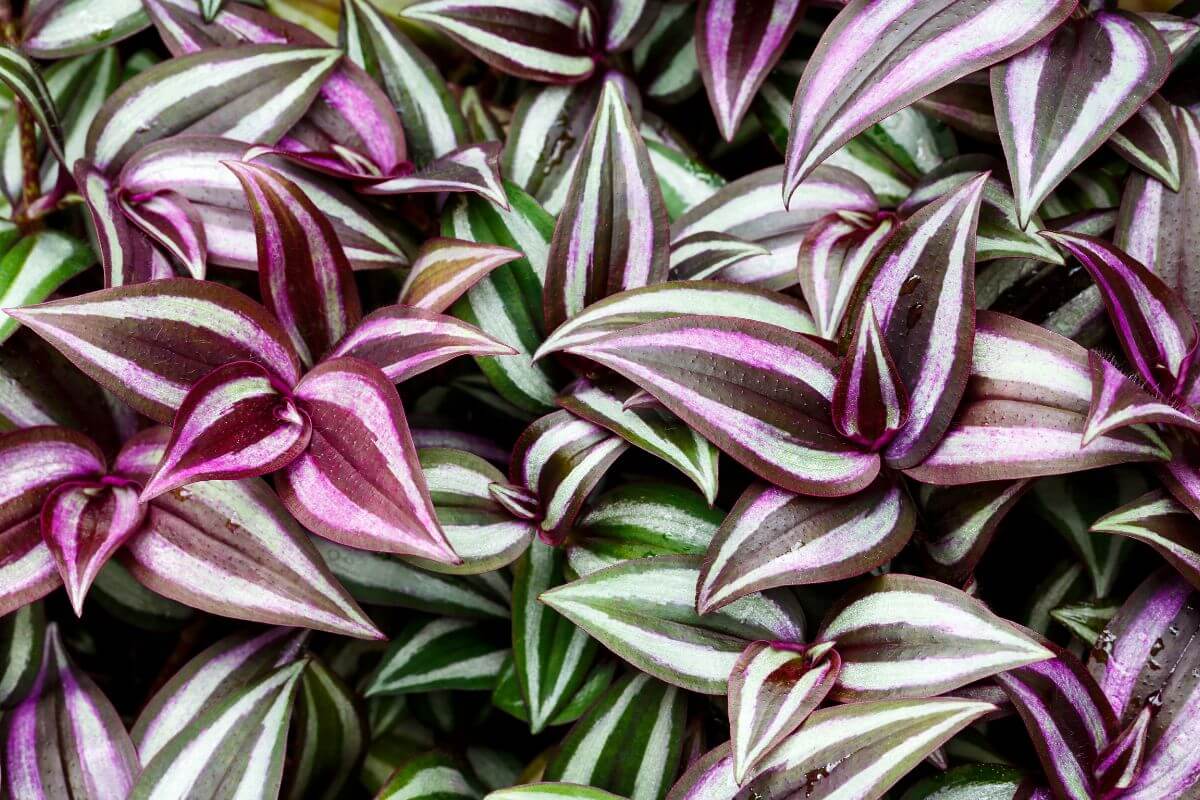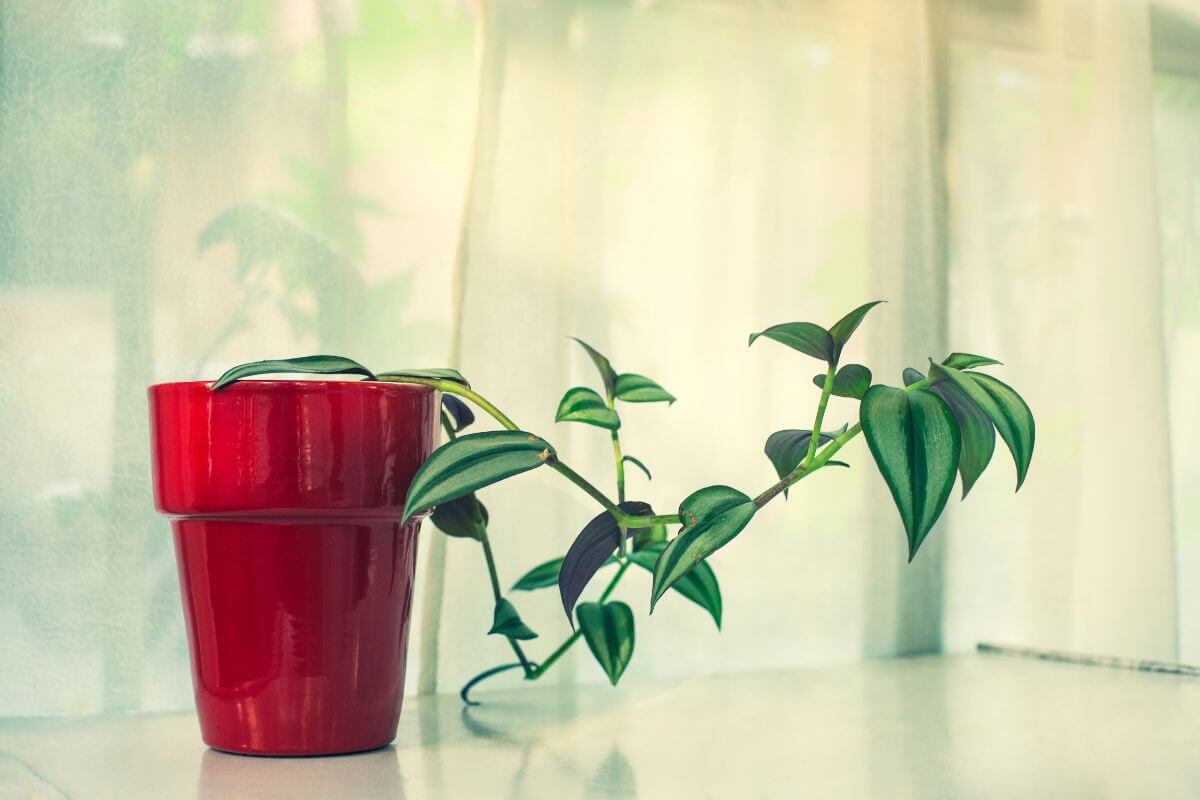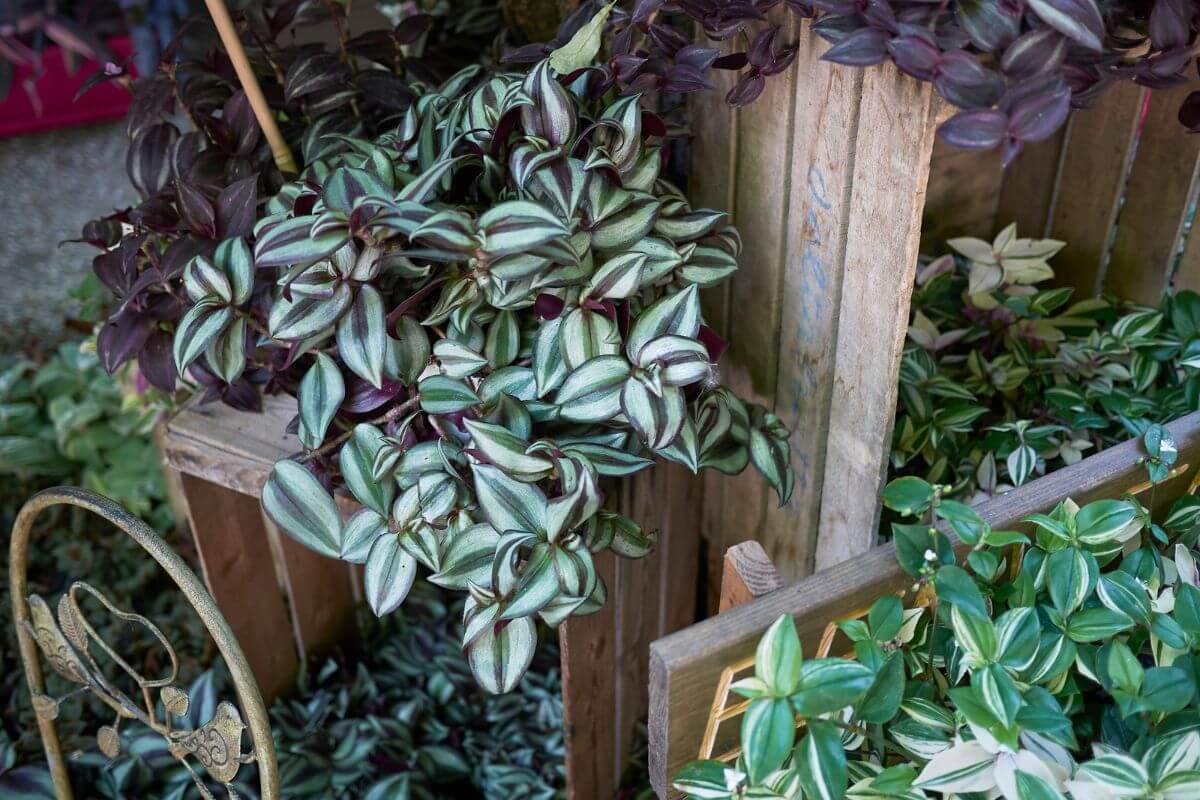The Wandering Jew Plant (Spiderwort) is a hardy houseplant that’s the perfect choice for home gardeners without a green thumb.
They are easy to care for and doesn’t take that much effort. This article will guide you through how to care for wandering jew plants and grow them successfully.
Wandering Jew Plant Overview

Natives of Guatemala and Mexico, the Wandering Jew Plant is an evergreen perennial. It can be cultivated outdoors in regions that are frost-free as a ground cover, where it will produce smallish, three-petaled lavender-hued blooms.
If you reside in a colder region, the wandering jew can be cultivated as a houseplant in pots or hanging planters, but most likely it will not flower.
The wandering jew has a couple of other common names – Spiderwort or the Inch Plant. The Inch Plant comes from the leaves being spaced approximately an inch apart.
Its colorful foliage is attention-grabbing in any décor with oval-shaped leaves that grow to about 2.5 inches in length, and stems growing to as much as two feet long.
They are a member of the Commelinaceae family, which includes over 650 species of climbers, herbs, and several epiphytes. Its part of the Tradescantia genus and offers numerous varieties.
Each variety is unique and will present its own difficulties. These plants are cultivated both indoors and outdoors as ornamentals thanks to colorful and variegated foliage.
Some of the more well-known varieties include:
- Tradescantia Callisia which features white bold striping.
- Tradescantia Flumeninsis features thinner leaves and stems than Zebrina varieties and comes in numerous colors and variations.
- Tradescantia Pallida “Purple Heart” boasts attractive purple foliage.
- Tradescantia Zebrina pendula with reddish foliage
Wandering Jew Plant Care Guide
An easy houseplant to cultivate indoors, the wandering jew plant will offer a lush and colorful addition to any corner of your home or office.
They require very little care and the only delicate aspect of their cultivation is keeping the soil bed nice and moist. They like moisture, but will not do well in a waterlogged potting mix.
Beautifully suited for a hanging pot or for a place on a shelf or table where they can cascade downward, they will thrive with lots of bright indirect light. They should be pinched back frequently to prevent them from becoming leggy or with stems that look bare.
While the wandering jew plant does not have a particularly long lifespan, it can be easily propagated with stem cuttings from the mother plant. This means that you’ll always have a wandering jew plant in your home.
Soil for the Wandering Jew Plant
The wandering jew plant will well in fresh potting soil. They like consistently moist soil and the only real risk is overwatering.
They need a well-draining soil bed and should never be allowed to sit in water or soggy soil. Their roots would be at risk for root rot.
To help with drainage, add some sand to your potting mix. The soil bed should be rich in organic matter.
Here are three options to blend your own potting mix:
- One part compost with one part potting soil.
- Equal portions of potting soil, peat and compost.
- Equal parts of compost, sand, and potting mix.
Light for the Wandering Jew Plant

The wandering jew plant will thrive in bright natural light that is indirect. Ideally, they should be placed near a window that can afford them at least eight hours of sunlight daily.
They should not receive direct sunlight, as UV rays can scorch the leaves. Should your plant’s color begin to fade, it is probable that your plant is not receiving enough light.
Water and Humidity for the Wandering Jew Plant
Moisture in the soil bed should be constant with these plants. They should be watered weekly during the spring and summer, their growing season. Water less often in the winter and fall when they enter dormancy.
To decide if it’s time to water your plant, place your fingertip a few inches down into the soil. If it feels dry, it is time to give your plant a drink.
The wandering jew plant prefers a humidity level that is a bit above average. If you have a place in your home that is humid, typically the kitchen or a bathroom, your plant will be happier there.
For other locations, you can use a small humidifier or mist your plant every several days. If the plant’s leaves begin to turn brown, your home’s humidity level is probably too low.
Another solution is using a pebble water tray. Place the plant pot on a tray filled with pebbles. You can either pour some water into the tray or allow the water from the plant to drain out into the tray.
That will create a humid atmosphere around the plant. It is important that the plant container sits above the waterline and does not touch the water.
Temperature for the Wandering Jew Plant
Wandering jew plants do well in a temperature range from 65° to 75° Fahrenheit. They will also be fine in somewhat warmer temperatures.
However, they should not be kept at temperatures that fall below 50°F. Lower temperatures can cause damage to its foliage.
Fertilizer for the Wandering Jew Plant
These plants do not require much in the way of feeding. You can fertilize every two months with a water-soluble fertilizer that is diluted to half its strength.
Be careful with too much fertilizer. If you overfeed it, the leaves of your plant may lose variegation.
The buildup of salts in the soil from the use of fertilizer can result in the burning of your plant. You can flush out salt by running water through your planter for approximately five minutes, or flush the plant outdoors with a hose.
Pruning and Repotting the Wandering Jew Plant

This is an aggressive houseplant that grows quickly. It can become leggy if it is not pinched back often.
To obtain a fuller, wider and bushier plant, prune back stems every so often, trimming to a joint. To prevent legginess, trim back stems by approximately a fourth of their length regularly.
Stem cuttings after they have taken root should be repotted in larger containers to ensure correct growth.
Mature plants should be repotted annually. Any type of container is fine as long as it has sufficient drainage holes. The choice of container material will influence how often you will need to water. When you repot, choose a new container one to two inches larger.
A clay or terracotta pot will most likely dry out the soil bed more quickly, whereas a plastic pot will maintain moisture longer.
Here’s how to repot the wandering jew plant:
- Remove the plant from its current container gently.
- Fill the new container about a quarter-full with potting mix.
- Control to see if the roots are bunched together and tease them apart if necessary.
- Place the plant in the new pot and fill it with new soil mix.
Propagating the Wandering Jew Plant
Wandering jew plants are easy to propagate with stem cuttings.
- Trim a piece of stem, about an inch in length that contains at least one leaf.
- Place the cut end directly into the potting soil.
- Water the soil regularly and within several weeks your new plant should take root.
- It does not require the use of a rooting hormone.
Wandering jew plants can also be rooted in water in a jar or glass:
- Fill the jar with approximately three inches of water.
- Remove leaves off the stem cutting that could be submerged.
- Place the stem cutting in the water and place it in a bright spot.
- The water should be changed when it is cloudy or every other week.
- After several weeks, new roots will form.
- When the roots reach a few inches in length, you can transplant your cutting to a pot with soil.
Wandering Jew Plant Toxicity and Pets

The Wandering Jew plant is toxic to dogs, cats, and horses. Typical indications of wandering Jew poisoning in pets may include:
- Dermatitis
- Itching
- Conjunctivitis
- Fur loss
- Muzzle irritation and redness
- Redness of the paws and between toes
- Redness eye area
- Palmar ulceration
For humans, in addition to the above symptoms, the sap may also be the cause of dermatitis in humans.
Wandering Jew Plant Pests, Diseases, and Problems
As with most houseplants, the wandering jew plant can be infested by either aphids or spider mites.
If you notice any indications of an infestation, treat your plant immediately with an organic insecticide such as neem oil. This insecticide is produced through the pressing of seeds from a neem tree. It is organic and will not harm humans or pets.
Neem oil is also considered safe for local wildlife, including birds, as it targets pests. This oil can treat aphids, whitefly, spider mites, and scale insects, among others. It is also effective against fungal infections such as blight, mildew, rust, leaf spot, etc.
Should the lower part of your plant’s stems begin to suffer leaf drop, it is a sign that your plant needs more light. In warmer seasons, you can give your plant a breath of fresh air by moving it outdoors to a spot with partial sun and partial shade. Avoid over-exposure to the sun.
Mushy stems or black foliage indicates root rot. Unhealthy plant parts should be cut away. Healthy parts can be repotted in a fresh soil bed. Rotted sections cannot be saved, so they need to be discarded.
Wandering Jew Plant Care Final Thoughts
If you are looking for a colorful plant to brighten up an indoor space, the beautiful, variegated foliage of the wandering jew plant is a winner.
Thanks to their hardy nature and their little care requirements, they are perfect for beginner gardeners or those who do not have a lot of time to dedicate to houseplants.
For other houseplants that are easy to care for, check out these guides:
- Polka Dot Plant Care and Grow Guide
- Shamrock Plant Care and Grow Guide
- Swedish Ivy Plant Care and Grow Guide
Wandering Jew Plant Care FAQs
Does the Wandering Jew Plant like sun or shade?
The Wandering Jew Plants likes bright, but indirect sunlight. Partial sun and shade are good for this plant.
Is the Wandering Jew Plant an indoor plant?
Yes, the Wandering Jew Plant is an indoor plant, but can also grow outside if given proper conditions. They require above average humidity levels, moderate temperatures, and consistently moist soil.
Is the Wandering Jew Plant bad luck?
Some people do believe the superstition that the Wandering Jew Plant brings bad luck. However, there has never been scientific evidence to support this belief. The only thing we know about the Wandering Jew Plant’s history is that its name comes from the legend of the Wandering Jew.
Is the Wandering Jew Plant poisonous to humans?
No, the Wandering Jew Plant does not contain any toxins harmful to humans. But the plant’s sap can cause skin irritation to humans. There is information out there that folk medicines utilize the sap and plant, but there are no scientific studies.
Does the Wandering Jew Plant attract bugs?
Yes, the Wandering Jew Plant attracts bugs because of its sweet scent. If you want to keep them at bay, try spraying your plants with neem oil. Aphids and spider mites are the most common pests that will affect this plant.
Do Wandering Jew Plants have fuzzy leaves?
Some varieties of Wandering Jew Plants have fuzzy leaves, while others do not. Of the ones with leaves that have a fuzzy texture, the colors of those leaves are usually green and purple.
Is the Spiderwort the same plant as the Wandering Jew Plant?
Yes, the Spiderwort is another common name for the more popular name, Wandering Jew Plant.


